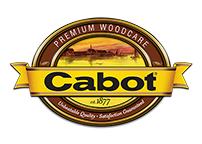
STAINING SIDING AND FENCES
Vertical surfaces, such as siding and fences, have different exposures, absorption rates and needs than horizontal surfaces. Follow these tips for pro-like results when staining vertical surfaces.
Make sure the wood is dry. Before staining, check to see if the wood is moist or dry. Stain that’s applied to damp surfaces won’t adhere well and will crack or peel. Moisture can also cause premature wood erosion, rot or decay. So you’ll want to make sure the wood is dry before staining it.
Caulk all joints. To prevent rain and moisture from penetrating behind your siding, fill gaps with a 100% acrylic compound, a paintable, siliconized acrylic blend, or a polyurethane sealant (for larger joints). Don’t overlook the roof-siding joint. If you have loose or missing caulking, replace it.
Look for surface problems. For the best possible results, never stain wood that’s eroded, decayed, rotted, contaminated, dirty or stained. If you notice any of these problems, you should either replace the wood or clean it, depending on the problem:
- Eroded, rotted and decayed wood should be replaced
- Contaminated, dirty or stained wood can be cleaned
HOW TO REMOVE CONTAMINANTS
Over time, the surface of wood can become contaminated with a wide range of substances, such as mildew, soot, rust and tannin bleed. Each of these contaminants has its own tell-tale signs—and each one requires a different treatment.
- Cabot Wood Cleaner is specially formulated to remove dirt, mildew stains and other foreign matter from all painted, stained, unfinished or weathered wood surfaces.
- Cabot Wood Brightener is ideal for removing discoloration of wood caused by rust and tannin bleed (stains that form when old stain begins to break down).
- For more information on how to identify and treat common surface contaminants, see our article How to Remove Surface Contaminants before Staining.
- Wood Toner—These clear and lightly tinted stains are nearly transparent, so they allow the most wood grain and texture to show through. View wood toned & clear stain colors.
- Semi-Transparent—Lightly pigmented, these stains impart more color the surface than wood toner stains, while still letting the wood grain to be seen. View semi-transparent colors.
- Semi-Solids—Our unique semi-solid/semi-opaque finish masks most of the wood grain, but allows some of the wood texture to be seen. View semi-solid colors.
- Solids—Choose these stains if you want a rich, vibrant opaque finish that completely hides the wood grain while allowing very little of the wood texture to show through. View solid colors.
- Our Project Helper was created to help take the strain out of choosing the right stain. Just answer a few questions and we’ll recommend the right stain for your project.

